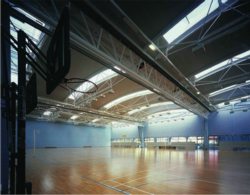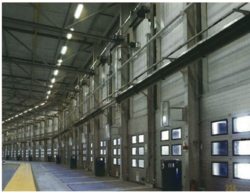Radiant heating for economy, versatility and comfort

Continuous radiant tube heating is particularly suited to sports halls. This is Bath University Sports Training Village, with a Nor-Ray-Vac system in the tennis halls and multi-purpose sports hall to provide even, low-intensity heat at 16 to 18°C.
Radiant tube heating is among the most economical forms of space heating on the market. It is clean, energy-lean and responsive. HOWARD MARFLEET looks at the options and applications for radiant heating.Faced with the challenge of selecting a new or replacement heating system for a large-space building, specifiers or building energy managers seeking to minimise fuel consumption should automatically look at the options for heating by radiant tube. This form of high-performance heating is effective in a wide range of applications where even heat coverage, rapid warm-up, quick heat recovery and flexibility of operation are required. Examples include sports halls, aircraft hangars, warehouses, automotive workshops, transport maintenance sheds and factories. Typically, radiant heating will reduce running costs by 25 to 60% in retro-fit applications, although this is occasionally beaten. In a recent heating decentralisation project for the MoD, energy cost savings of 64% were achieved by replacing a boiler and high temperature hot water system with gas-fired radiant tubes from Ambi-Rad. Low operating costs are achieved by concentrating the heat at low level, where it is most needed, without heating the volume of air in the building. Rapid response times reduce running costs still further. Such flexibility means that warmth is felt by people in the building within minutes of start-up on cold mornings — no fuel is wasted bringing the air to a comfortable temperature. By contrast, some conventional convection systems may take up to an hour to reach comfort conditions. Similarly, when external doorways are opened — periodically or for long stretches of time — people working in a building heated by a radiant system continue to feel warm. When the doors are shut again, comfort temperatures are restored almost instantly. Minimal heat is lost through the doorway, or through the roof. Should a facility be down-sized, or activity confined to only one or selected areas of the building, radiant heating can be configured to heat only where required. This is called zone control and is a further energy-saving measure. It is particularly useful where activity takes place in different parts of the building on a daily basis — such as in an aircraft maintenance hangar. The building will not be fully utilised all the time, but selected areas will be occupied when planes are brought in for service and repair at different times. Most importantly for many applications, especially environments where small particles and dust may be present in the air, radiant systems heat without air movement. In this context, radiant may be a trouble-free option for heating, where the air movement associated with a convection system would tend to disturb particles in the air. Since a radiant system burns fuel at the point of use, there are no distribution losses. Gas-fired radiant-tube heaters need to have a net thermal efficiency of 86% and a minimum radiant efficiency of 60% for inclusion on the Government’s Energy Technology List and be eligible for Enhanced Capital Allowances. Radiant-tube heating is mounted overhead, often at very high level — normally between 4 and 12 m, although mounting heights of 25 m are not uncommon (to accommodate cranes, for example). The gas burner fires a flame along the inside of a black steel tube causing it to heat up. The external surface temperature of the tube can reach 400 to 700°C, at which point the tube emits radiant heat. This is reflected downwards by a highly polished reflector.
Types of radiant heater Linear or U-tube: These ‘straight-line’ heaters are positioned at strategic points to provide excellent heat coverage around the building. Often used in high-bay factories or automotive workshops for maximum effectiveness and flexibility, but they can also have unusual ‘tailored’ applications. At Interlink Express’s national distribution centre in Smethwick, for example, where around 110 000 parcels are processed every night, 27 AR22SL linear radiant-tube heaters were positioned over the doorways about 3.5m above ground level. The system effectively and economically heats the area immediately around the 95 loading-bay doors while they remain open during the night.
Continuous radiant tube: Continuous radiant tube offers all-round, low-intensity warmth in a variety of settings. It is particularly suited to sports halls, where it can be set to a lower temperature than would be normally required, yet still achieve the required feeling of warmth for both athletes and spectators. At Bath University Sports Training Village, a new university/community sports facility, Nor-Ray-Vac continuous radiant tube heating with 24 burners with outputs from 24 to 38 kW was installed in the tennis halls and multi-purpose sports hall to provide even, low-intensity heat at a constant 16 to 18°C. Continuous radiant tube has the advantage of being quiet, aesthetically in keeping with the surroundings, convenient (in that it does not take up valuable floor space) and safe.
Packaged compact units: The latest type of radiant heater to come on to the market is the packaged unit, such as the Vision Compact from Ambi-Rad. This heater arrives on site in shrink-wrapped packaging, which can be left on during installation to protect heaters from dirt, knocks and scrapes during non-related building work. The packaging can simply be removed at commissioning stage.

Linear radiant-tube heaters above the 95 loading-bay doors at Interlink Express’s national distribution centre in Smethwick heat the area around the doors while they remain open during the night.
Radiant plaque heaters: Suitable for high-roof buildings that suffer frequent air changes, or for spot-heating applications, ceramic-plaque heaters provide ‘instant’ heat exactly where it is needed. These small units offers all the advantages of larger radiant models. • Quick warm-up (the Solarglow from Ambi-Rad can reach 1000°C in just two minutes). • Minimal air movement. • A high level of comfort. Economically, plaque heaters offer lower running costs, lower capital costs and lower installation costs due to their lightweight construction and ease of handling.
Howard Marfleet is Business Development Manager of Ambi-Rad Ltd. Fens Pool Avenue, Brierley Hill, West Midlands DY5 1QA.
Related links:










